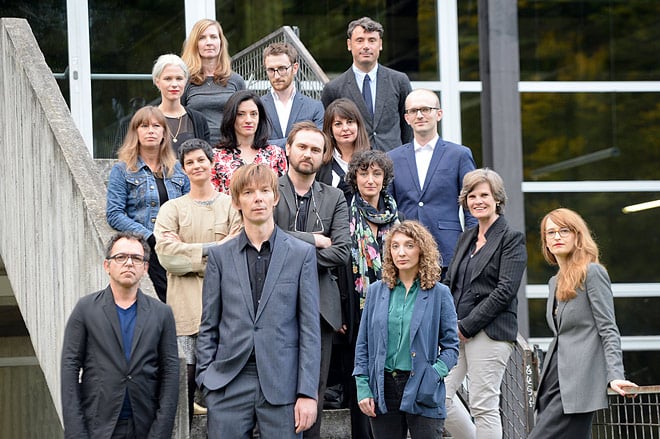Art & Exhibitions
Nine Things We Know So Far About documenta 14
The quinquennial event kicks off next month in Athens.

The quinquennial event kicks off next month in Athens.

Alyssa Buffenstein

With less than a month to go, the documenta 14 is still shrouded in mystery. Notoriously secretive about participating artists, organizers have revealed very littler about what visitors can expect. As a result, there’s much speculation around the upcoming show, which takes place April 8–July 16 in Athens, and June 10–September 17 in Kassel, Germany.
The documenta exhibition has taken place for 100 days every five years in Kassel since 1955. Founded by Arnold Bode, the “museum of 100 days” began as an exhibition of contemporary art that could bring postwar Germany up to speed on international contemporary art, following years of it being deemed “degenerate” by the Nazis, and shunned, sold, or destroyed in war.
It has historically always taken place at the Fridericianum—the first museum in mainland Europe, established in 1779—later adding other locations around the city of Kassel, which was heavily bombed in World War II.
But this year, curator Adam Szymczyk is shaking things up and splitting the exhibition between Kassel and Athens, Greece, with an exhibition titled “Learning from Athens.”
Despite the secrecy, some details have been confirmed, so here’s everything we know so far about documenta 14:
1. There are over 150 participating artists
Around 150 living artists were sent written invitations to have current work featured at documenta 14. Generally, most create new works, and there will also be a selection of historic pieces. Artists were first invited to Athens, then to Kassel, and some will show in both cities. None have yet been revealed—Szymczyk told the Deutsche Presse Agentur he was “not a friend” of artists lists released in advance, since they build expectations before the show even opens.
“In my opinion, an exhibition should be an experience. An experience without great programmed expectations,” he said.

Documenta’s traditional home, the Kunsthalle Fridericianum in Kassel. Photo: Carroy via Wikimedia Commons
2. It will span multiple venues in both cities
Historically, the exhibition has taken place at the Fridericanium and, since DOCUMENTA IX in 1992, the nearby documenta-Halle. This year, it will also make use of “nearly all the public museums in Kassel,” Szymczyk told DPA, including the Grimmwelt museum, historic Ballhaus, and a former post office that is now a fitness studio. Friedrichsplatz, the public square around the Fridericianum, will also “play a big role.”
In Athens, the exhibition will occupy the National Museum of Contemporary Art in Athens (EMST), as well as an exhibition hall, the modern extension of the Benaki Museum, and other smaller venues. EMST will be the largest venue.
3. There will be an exchange between museums in Athens and Kassel
According to a press release, a curated selection of Greek and international art from EMST’s collection will be shown at the Fridericianum, in order to make space for the Szymczyk-curated exhibition and to, presumably, allow Germans and international visitors to “Learn from Athens.”
4. Szymczyk wanted to bring the Gurlitt Collection to Athens, but couldn’t secure it
The curator wanted to show the collection of Cornelius Gurlitt, a trove of more than 500 artworks said to have been wrongfully taken from their owners during World War II, including canvasses by Matisse, Courbet, and Chagall. When news of that broke, it was controversial, but it’s all irrelevant now, since “legal and political restrictions” stood in the way. Nonetheless, it continued to serve as inspiration for Szymczyk and his team, specifically in the design of the exhibit in Kassel’s Neue Galerie.
5. There will be an obelisk
One work is out of the bag so far (It’s hard to keep an obelisk a secret). It will be installed at Königsplatz, in the neighborhood of Fridericianum. A spokesperson for documenta told DPA that work has already begun on the construction, but wouldn’t give any word on the artist behind the monument.
6. The exhibition costs €34 million ($36.25 million)
Around half of that expense is paid for with public funds by the city of Kassel, the state of Hessen, the German Federal Cultural Foundation, and the Federal Foreign Office. documenta raises the other half itself, and has sponsors including the Sparkasse Finance Foundation and Volkswagen, besides private sponsors in the form of both individuals and foundations. Artists are paid for production costs and retain the rights to their works after the exhibition.
7. It will be participatory
Visitors to documenta 14 are expected to be “active participants” in the show, rather than just passive viewers.
“There is a large untapped potential when visitors come together for an exhibition—a political potential,” Szymczyk said.
8. Tickets in Kassel will cost €22 ($23.50)
For a single day pass, at least. A two-day pass costs €38 ($40.50), and a long-term ticket valid for the duration of the show will run you €100 ($106.50). In Athens, many of the venues will be accessible free of charge, but some partner institutions will still charge their regular entrance fees.
9. Visitors can fly directly from Kassel to Athens
Aegean Airlines became the first airline partner in documenta’s history, announcing last year that a new direct line connecting Kassel and Athens would be launched especially for documenta 14. There are two flights per week operating between the two locations, and a quick search on the airline’s website yielded plenty of available seats at reasonable rates.